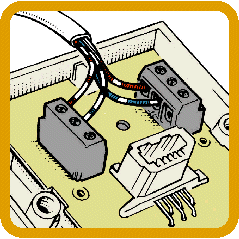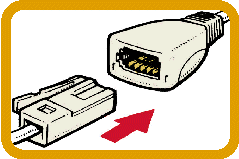| An additional telephone extension can
be provided by using a multi-adapter or by adding a new telephone extension
socket. In more complex systems, a junction box may be needed to join up to
four lengths of telephone cable end to end. To convert a single socket to a multi-socket outlet, Double and 3-Way Telephone Adapters are available. It should be noted, however, that running more than one lead from a single telephone socket might impair performance of the telephone equipment. The best option is to add in a new telephone extension socket. Extension sockets are added to the existing telephone system from the master socket, which is installed by the Telephone Company, such as British Telecom (BT) or Mercury. Extension sockets must not be used as replacements for the existing master socket. There are basically two types of BT master socket: 1. NTE5 Socket This type of socket is used on all new BT installations. The lower front half is removeable to allow you to connect extensions by ‘hard wiring’. 2. BT ‘old’ socket This older type of socket is the former socket used in BT installations. You can only connect extension sockets by plugging in.  If your telephone line is provided by an operator other than BT, your socket may be different to those shown above. Contact the telecommunications operator for further information. Types of Extension Socket There are two basic categories of extension socket: 1. Flush Mounted Extension Sockets If you are installing a telephone extension and have easy access to the wall, flush mounted extension sockets are the best way to supply a telephone extension to another room. Flush mounted outlets fit on a standard 25mm deep single metal mounting box, which is recessed into the plaster. Alternatively, they can also be mounted on plastic surface mounted boxes. Telephone Flush Extension Sockets are available with both singel and twin sockets.  2. Surface Mounted Extension Sockets If you do not have access to the walls, the most common extension socket is a surface mounted outlet box which is available in either a standard format or a compact version.  |
| Connecting Telephone cable into an
Extension Socket When connecting telephone cable in extension sockets, the following colour code must be observed:  1 Green/white ring 2 Blue/white ring 3 Orange/white ring 4 White/orange ring 5 White/blue ring 6 White/green ring N.B. It is usual to only use 2, 3, 4, and 5 for domestic installations. To connect the telephone cable into the back of outlet sockets there are two types of connection available - screw terminal and IDC. Screw terminal connections Prepare the cable by stripping away 20- 30mm of outer sleeve exposing inner wires. Remove approximately 5mm of inner insulation to expose bare wire. Follow the colour code. Loosen screws, insert wires under screws and lightly tighten ensuring secure connections. IDC terminal connections Prepare the cable by stripping away 20- 30mm of outer sleeve expsing inner wires.  Do not remove inner wire insulation. Following the colour code, lay each wire in the corresponding notch of the connection terminal. Use the IDC Cable connecting tool to firmly push the wires into the terminals. Connect the telephone directly into extension socket or to extend the distance from the socket to the telephone. Telephone Extension leads are available in 2m, 4m and 10m lengths.  |